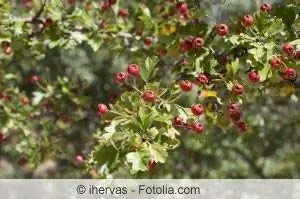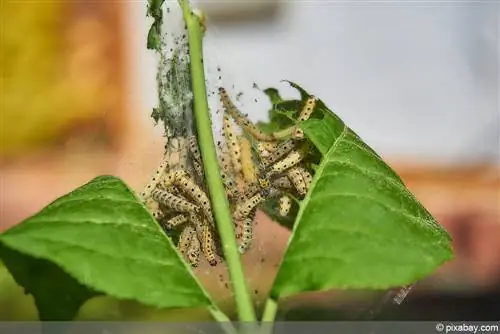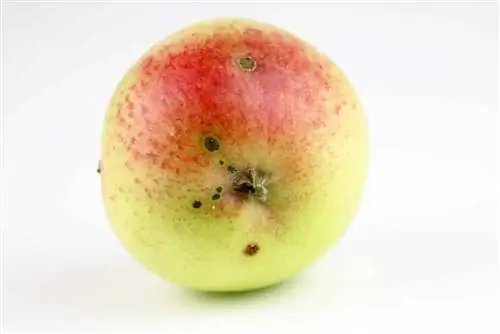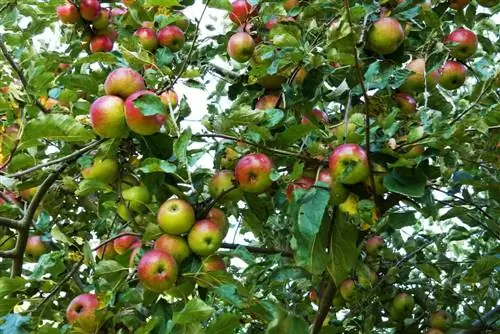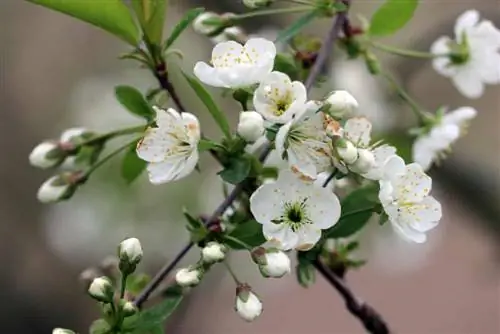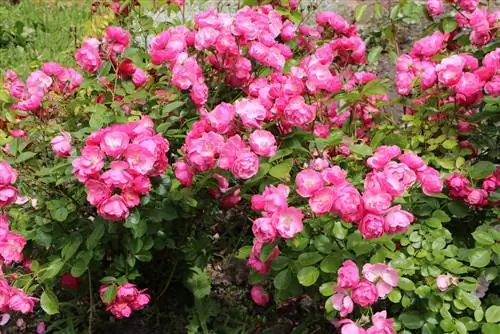- Author admin [email protected].
- Public 2023-12-17 03:39.
- Last modified 2025-06-01 06:48.
Do you love flowering plants in the garden that also produce usable fruit? Then an apple thorn could be the right thing for you and your garden.
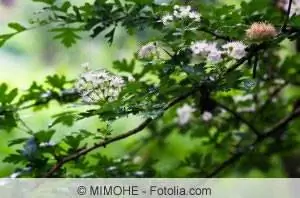
The apple thorn is actually called apple-leaved or leather-leaved hawthorn or botanically Crataegus lavallei, it was bred in France in 1870 by Mr. Lavalle as a cross between the cockspur hawthorn and the Mexican hawthorn. Like all Crataegus, hawthorns, it belongs to the subtribe of the pome fruit family, one could say, a clan in the large family of the rose family.
As a pome fruit plant, hawthorn is related to apples and pears, which it shows by producing small apples. It proves its origins from the large rose family with its lush flowers and impressive thorns. The apple thorn is therefore a very beautiful garden decoration; the white-pink flowers appear from May, followed by the orange to red apple fruits, and in mild weather they sometimes remain on the tree until January. Even the leaves take part in the decoration, but only for a short time, because when they have turned yellow-brown to orange in late autumn, they will soon fall off.
By the way, an apple thorn is very suitable for shading a seat, because it has such hard leaves that many insects don't like to visit it.
Apple thorn as a standard trunk - care and cutting
The standard stem is probably the most common form in which you can buy the apple thorn. The leather-leaved hawthorn prefers a sunny location in fairly nutrient-rich soil; it also tolerates partial shade and lighter soil. Otherwise, the apple thorn is not very demanding: it is windproof and frost hardy, and can withstand drought and heat well. It is very compatible with cutting and has nothing against urban climates, even when it comes to urban climates in the immediate vicinity of a main road.
The apple thorn as a standard tree is basically cut in the same way as all fruit trees. The correct pruning of fruit trees differs from variety to variety, in addition to some basic characteristics such as the pyramid shape and the promotion of evenly pronounced leading branches as the goal. The good thing about the apple thorn is that it only reaches a size of around 7 meters. It is therefore quite easily accessible for cutting in the upper area.
However, when choosing a location and cutting, you have to remember that it tends to be quite wide. If you don't want the older tree to grow twice as wide as it is tall, you have to make sure from the start that you prune the crown frequently and thereby keep it small and, above all, narrow.
Usable fruits
The fruits of the apple thorn are edible and rich in valuable ingredients: They contain carotenoid as a coloring agent, which acts as an antioxidant in our body, and a lot of vitamin C. The only annoying thing is that the apples are only up to two centimeters long become. They also taste so floury that most people don't get excited about eating them raw. However, you can make many tasty things from the fruits if you process them further:
- Jam and jelly,
- Lemonade,
- Compote
- or a fake “apple schnapps” - with whole, tiny apple fruits!
Apple thorn - pests and ecological benefits
Warnings keep circulating on the Internet that one should avoid the apple thorn because of its susceptibility to fire blight. It is actually true that the apple thorn, like some apple and pear varieties, is susceptible to fire blight. The horror reports from the Internet mostly go back to the fire blight infestation that caused terrible damage around Lake Constance in 2007; the disease has since been reportable (Fire Blight Ordinance).
But that doesn't mean that it is generally considered sensible to limit the risk of possible pest infestation by further reducing biodiversity and only planting pest-resistant trees. Check with the local nature conservation authority about the fire blight risk in your area, they will certainly be able to tell you something about how at risk your area is in terms of fire blight and whether planting an apple thorn is considered useful.
From an ecological point of view, however, the nature conservation authority could advise you to plant a native, single-handled or two-handled hawthorn (Crataegus monogyna) instead of an apple thorn. As already indicated above, not all native insects and even some bird species like apple thorn, while the native hawthorn has a high ecological value. It is an important source of food and habitat, providing a basis for life for around 150 species of insects, a good 30 species of songbirds and many small mammals.
More care tips
Like its ancestors, the apple thorn loves a sunny location and light to medium-heavy soil, ideally slightly calcareous. Otherwise it is very robust. Its leathery leaves are less popular with pests, which is why aphids or other pests rarely appear on it. An apple thorn usually survives longer dry periods quite well and extreme cold in winter does not harm it either. It is absolutely easy to care for. Nevertheless, he is happy about a watering when it hasn't rained for a long time and about some ripe compost in the spring.
Cut apple thorn
The exterior differs according to its cultivation: an apple thorn is either a large shrub or a tree with a small crown. The same is true with cutting. As a shrub, an apple thorn grows particularly wide, so it probably has to be stopped for reasons of space.
- If the bush becomes too dense in the center, it makes sense to cut out some branches completely. The ideal time for this is February or March on a frost-free day.
- As a young tree, pruning forms the basis for its further growth. Similar to a cultivated apple tree, only a few branches should be left with enough space between them so that the crown has an even appearance.
- Later, light thinning cuts will only be necessary if necessary. Even if branches grow crosswise or bulky inwards, it is better to remove them so that they do not rub against other branches and the bark comes off.
Such open places are often attacked by bacteria and fungi that damage the tree. Therefore, it is better to intervene in good time. Otherwise, pruning on the apple thorn is not absolutely necessary.
Is an apple thorn poisonous?
In contrast to firethorn, where the seeds are slightly poisonous, the fruits of an apple thorn can be eaten without hesitation. However, they taste very floury. If you still want to use them, you can make delicious jam out of them. The birds in winter are also happy about a richly set table. They like to feast on a tree that is full of fruit when nature doesn't have much else to offer.
The apple thorn has steadily increased in popularity in recent years. This is certainly due to its appearance, which has something special to offer at any time of the year: a dream of flowers in spring, bright orange-red fruits that adorn the branches until January and beautiful autumn color until December. Since an apple thorn doesn't grow that big, it also fits into very small front gardens.

